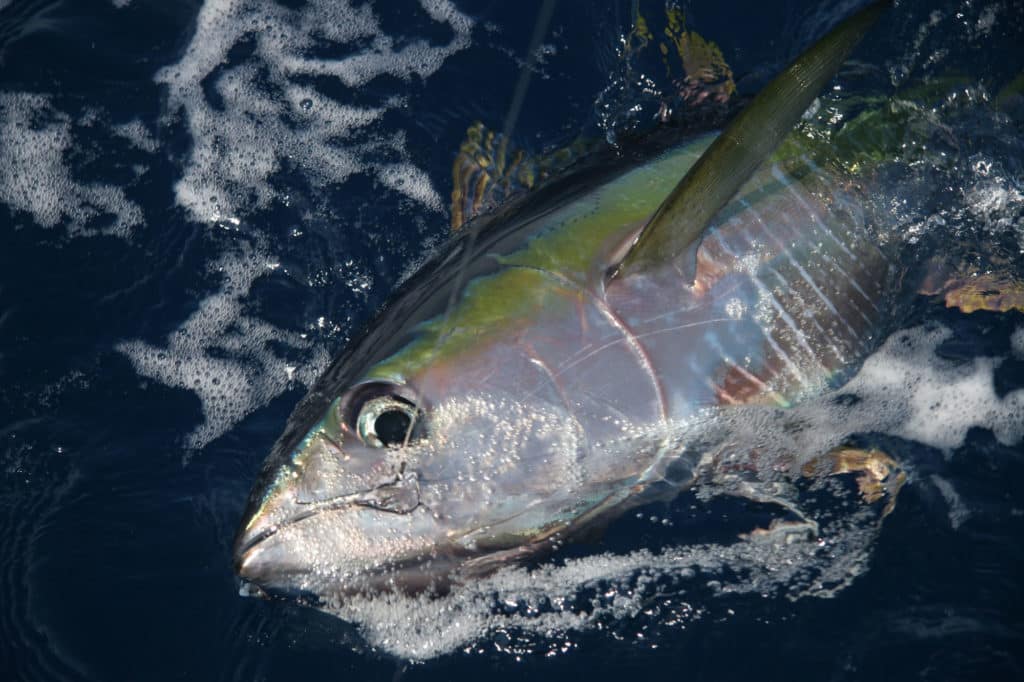
Yellowfin tuna attack in packs, like wolves descending on a flock of lambs. Often, these 50-pound footballs launch completely out of the water to crash bait from above.
On the hook, they fight like bulldogs with a headstrong run capable of pegging anglers to their limits. On the table, the meat tastes delicate, whether seared like a steak or sliced up cold and raw.
Among the top locations to catch this most-popular gamefish has to be Hatteras Island, North Carolina. Captains troll ballyhoo, cast topwater plugs, dangle baits from a kite or jig vertically. Fishing out of the famed Oregon Inlet, on the east side of Hatteras island, or the fabled Hatteras Inlet on the south side of the island, anglers find ample opportunities to catch the yellowfin tuna of a lifetime.
On the Line in Oregon Inlet
The combination of warm-water eddies and deep structure attracts tuna to the waters off Oregon Inlet from October through June. While blackfin, bigeye and bluefin tuna visit the area, yellowfin tuna remain the star attraction.
The charter fleet fishing out of Oregon Inlet developed the tactics that anglers all over the world use to score yellowfin. Based out of Oregon Inlet Fishing Center, Capt. Charles Haywood chases tuna on his 55-foot custom boat, Rigged Up.
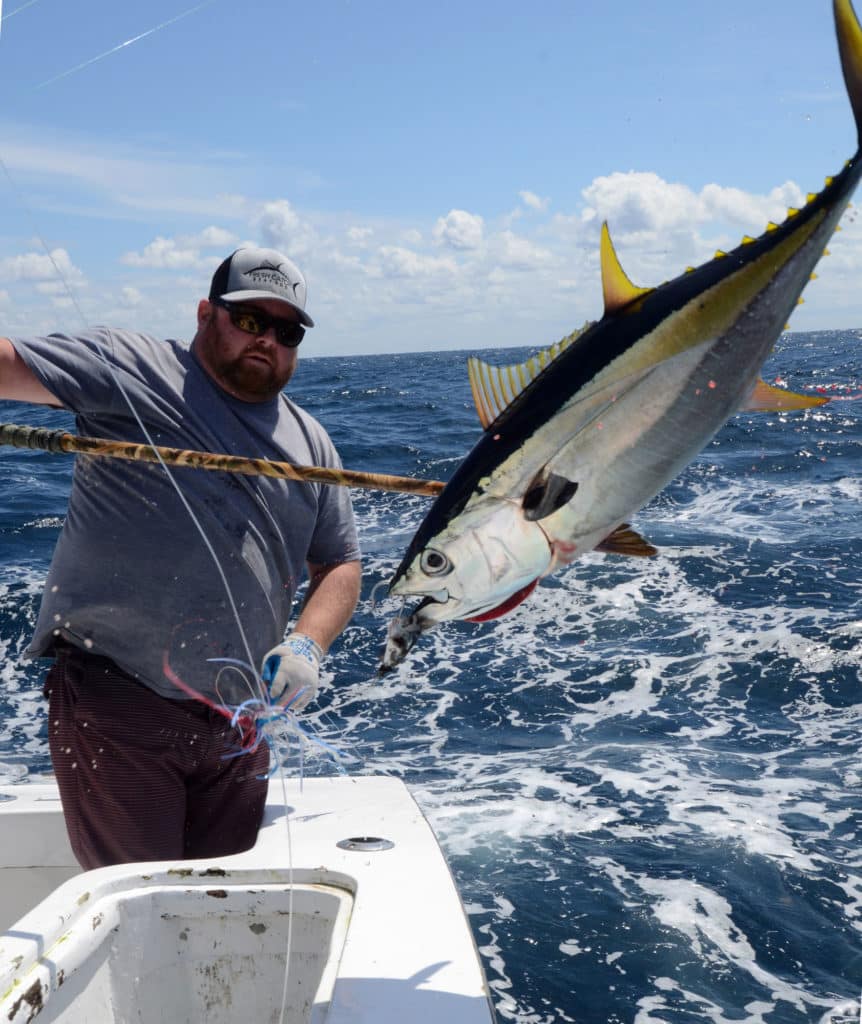
Haywood has fished Oregon Inlet since childhood, starting as a mate for some of the most iconic anglers on the water and later becoming the owner operator of his own boat. After decades chasing yellowfin, Haywood and the rest of the tuna fleet have developed foolproof tuna tactics.
“We can catch yellowfin tuna all winter,” Haywood says. Later, the spring season heats up from early May to late June. While every angler prays for calm weather, Haywood says the best tuna days are a little rough. “Not hell-bent, but a 12- to 18-knot wind seems to get the fish moving,” he says. On a stiff northeast swell, he spots schools of yellowfin swimming downsea.
Getting to The Point
Haywood looks for yellowfin where the edge of the Gulf Stream crosses the continental shelf, anywhere from 30 to 50 miles offshore. Ground zero is a cut in the shelf called The Point. The warmer, clearer water of the Gulf Stream meets the cooler, dirtier water of the Labrador Current in a noticeable seam. As the currents ebb and flow, the seam moves north and south along the edge of the shelf. When the warm water crosses over a hill, cliff or canyon in the edge of the abyss, yellowfin tuna stage to feed.
“This time of year, yellowfin will hold inside or outside the stream,” he says. Haywood has caught yellowfin in water from 68 to 78 degrees; he says 70 to 74 degrees is ideal.
Haywood relies on his fish finder to mark tuna and bait as the boat moves from one piece of structure to another. Once he finds fish on a hill or canyon, he works the area until he dials in specific locations and determines the best direction to approach them.
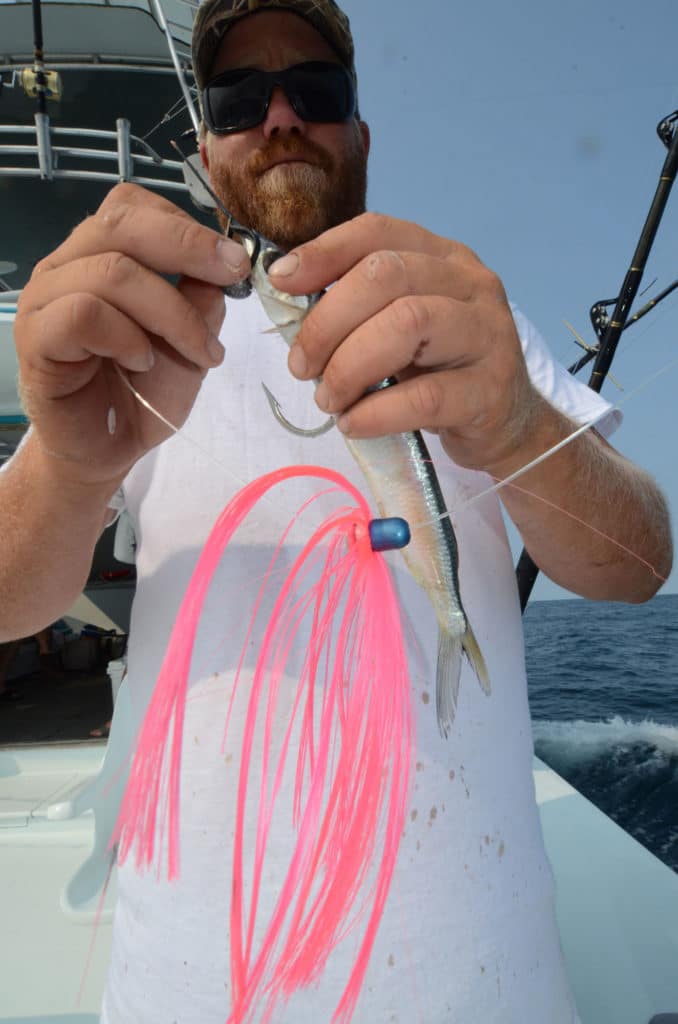
The Perfect Spread
To catch yellowfin, Haywood trolls skirted ballyhoo at 6.5 to 7.2 knots. He starts with a large ballyhoo rigged beneath a Sea Witch skirt. Haywood keeps a complete palette of skirt colors, from black-and-red to bright pinks and whites. He changes colors to meet weather and water conditions.
He pulls the ballyhoo using 50-pound-class tackle and spools up with 130-pound braided backing. To the backing, he adds a 100-yard topshot of 80-pound mono and crimps a 25-foot leader of 180-pound fluorocarbon between the topshot and the lure.
An effective tuna spread consists of a dozen baits fished from a web of lines. Haywood makes use of long riggers to long-short riggers, short-short riggers, two or three shotguns and flat lines splashing just a few feet from the transom.
Haywood recommends changing each lure’s position until it swims correctly: riding down the boat wake and popping out of the water every minute. Sometimes the fish favor long baits swimming deeper and other times, the tuna attack short baits splashing on the surface. With the right spread, a pack of yellowfin will attack every bait until every rod bends double.
After the first bite, Haywood keeps trolling, hoping to hook multiple fish. By the time he slows the boat to let the anglers work on the fish, he has moved away from the structure. With the swift Gulf Stream sweeping him away from the honey hole, Haywood turns his boat into the current while the anglers fight their fish.
When the spring bite turns hot, anglers descend from every direction to get in on the action. Chartering a professional captain can help you learn the ropes.
Haywood also encourages visitors to network with local captains to monitor weather conditions and navigation hazards. The channel markers don’t mark the channel, and a big winter swell can make the outer bar almost impassable. “We may be tough on the outboarders,” he laughs, “but the inlet is always changing. Don’t be afraid to ask for local knowledge.”
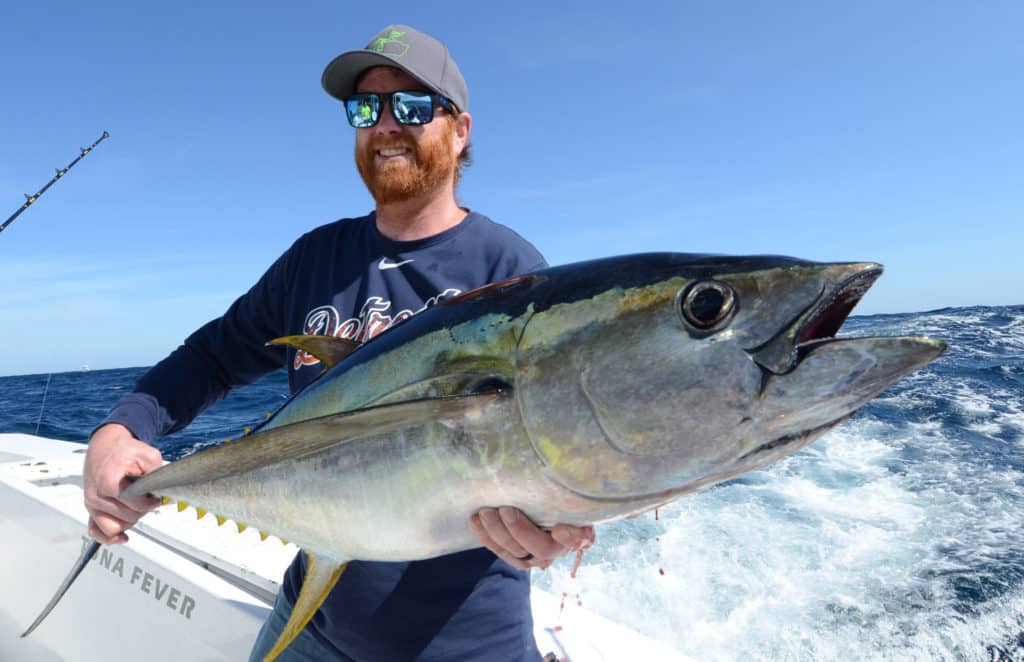
Chasing Action in Hatteras Inlet
Although it lies only 60 miles south of Oregon Inlet, Hatteras Inlet is a world away. While the fleet fishing out of Oregon Inlet enjoys steady action on yellowfin tuna, anglers fishing out of Hatteras Inlet chase tuna that ride eddies of cooler water spinning along the Gulf Stream.
Capt. Rom Whitaker has chased yellowfin out of Hatteras Inlet for 40 years. “Ten years ago, tuna fishing was excellent,” he recalls. Then, local anglers suffered a dry spell — until last year.
Whitaker says the behavior of the Gulf Stream eddies changed. “We had less current and more eddies,” he says — perfect conditions for yellowfin tuna.
The Gulf Stream current can rush faster than 5 knots up the coast, and that deep, blue water is too warm and turbulent for tuna. Instead, Whitaker looks for an eddy of cooler, slower, green water spinning up from the south.
“The water in the eddy can be 3 degrees cooler,” he says. “As the eddy moves up the coast, the current will change from southwest to nothing to a backing tide out of the northeast.”
For this reason, Whitaker starts each day studying satellite sea-surface-temperature images. While on the water, he monitors changes in the eddy with his Sirius XM satellite service. He also talks to captains who fish out of Morehead City to the south, asking about water temperature, current and other details for clues to where the tuna are holding—on the edge, in the center, or at the top or bottom.
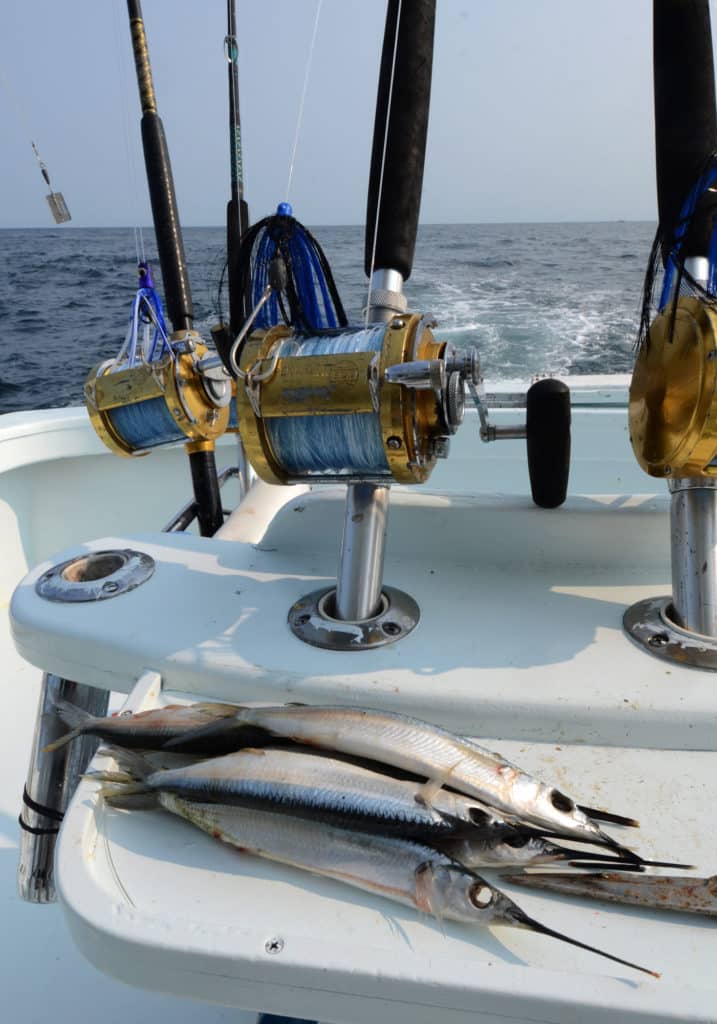
Once he determines the most likely area, he looks for where the water crosses underwater structure. “The tuna ride the eddy like a train,” he says. The fish might stop at canyons and rock piles, but they continue to move with the water. “One day they might be south at the 800 line, then the next day they’ll be at the triple zeros, and the third day, they’ll stop behind the Rockpile,” he says, referring to Loran-C locations.
Shifting Tactics With the Seasons
Whitaker says the Hatteras yellowfin season runs from April until early July. As the months progress, his tactics change. He prefers trolling Sea Witches and ballyhoo. If that doesn’t work, he might try dropping a spoon on a planer, or adding a spreader bar into the mix. “I like the spreader bar in the middle of the spread,” he says.
If Whitaker marks fish on his fish finder, but can’t get a bite, he drops 200-gram vertical jigs. If he sees yellowfin jumping out of the water, he grabs a spinning rod rigged with a topwater popper. But his favorite way to catch tuna is with the kite, he says.
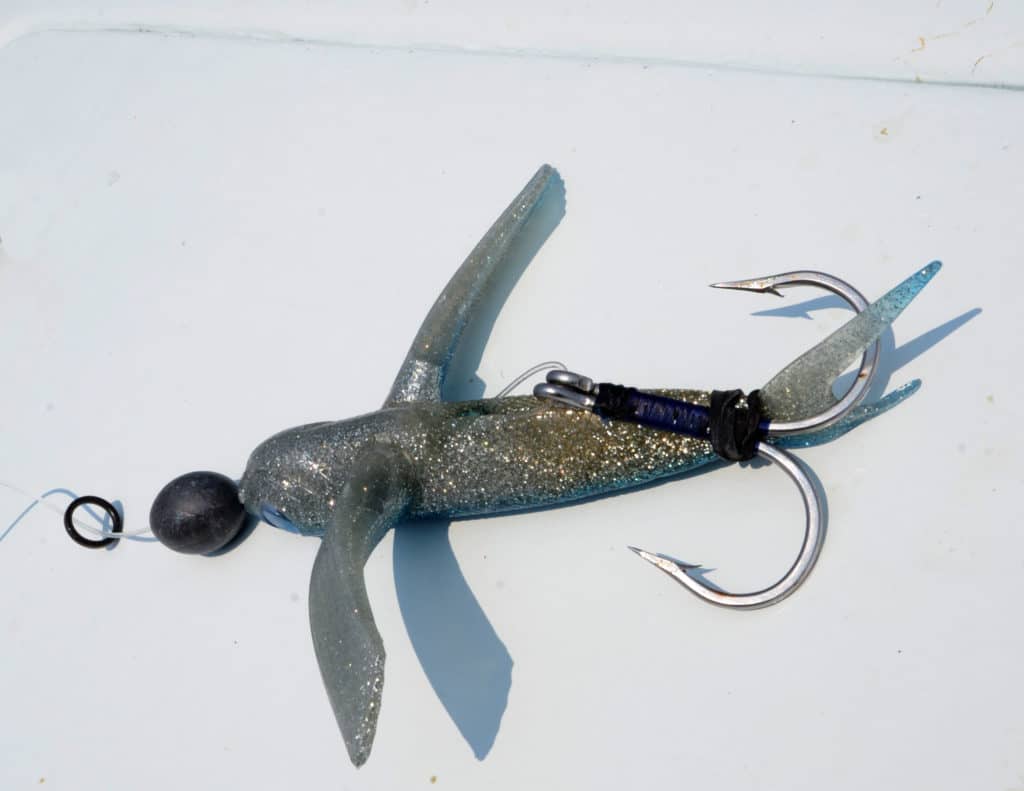
When the tuna feed on flying fish, they turn up their noses at trolled baits. Dangling a rubber flying fish from a kite can be just the thing to entice the tuna to bite. Whitaker uses 30-pound tackle spooled with 65-pound braided line. He attaches the mainline to a 4-foot section of 200-pound monofilament holding the lure. He can run two lures off one kite, trolling fast enough to keep the kite in the air and the lures bouncing off the wave tops.
Read Next: More Yellowfin Tuna Tips
“It’s a very visual bite,” he says, describing how tuna launch into the air to snare a flying bait. Yellowfin seem to prefer their prey hanging three feet off the surface. With a lot of line in the air, it’s important to quickly retrieve slack. Sharp hooks snare the fish until the angler can catch up using the reel.
On a typical day tuna fishing, anglers might have to employ several tactics before hitting the mark. Expect to switch from trolling ballyhoo, to casting plugs, jigging metal and flying a kite. But if you can find the right water over the right structure, you’ll find some of the world’s best yellowfin tuna fishing.
FAQ
How far offshore are yellowfin tuna?
Yellowfin tuna are typically found offshore, often 30 miles or more from land in open waters. However, they can also be encountered closer to shore if there are deep water trenches, canyons, or upwellings that bring nutrient-rich waters and baitfish near the coast.
What depth are yellowfin tuna found?
Yellowfin tuna are capable of swimming at a wide range of depths, from the surface down to around 800 feet (244 meters). They often inhabit depths of 200-600 feet (61-183 meters), following the vertical migration of baitfish and other prey.
What is the biggest yellowfin tuna ever caught?
The all-time record for the largest yellowfin tuna caught on rod and reel was a massive 427-pounder (193.7 kg) landed by angler David Chee off Magdalena Bay, Baja California Sur, Mexico in 2010. It measured 98 inches (249 cm) in length and had a girth of 71 inches (180 cm).








